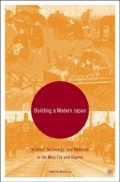Abstract
This chapter examines the impact of the Great Depression on business-state relations in Japan through a case study of the cotton textile industry. A common perception holds that the challenges of the Great Depression ushered in the era of state control of the Japanese economy. The experience of the cotton-spinning industry, however, suggests a different result. In fact, the challenges that executives overcame in the late 1920s and early 1930s bolstered their confidence in the efficacy of industrial self-governance and strengthened their conviction in the need for autonomy from the state. The most vexing issue became overseas trade barriers, a problem that first appeared in the 1920s.
Access this chapter
Tax calculation will be finalised at checkout
Purchases are for personal use only
Preview
Unable to display preview. Download preview PDF.
Notes
Nakamura Takafusa, “The Japanese Economy in the Interwar Period: A Brief Summary,” in Japan and the World Depression: Then and Now, ed. Ronald Dore and Radha Sinha (London: The MacMillan Press, 1987), pp. 52–67, on p. 61, and idem., Lectures on Modern Japanese Economic History, 1926–1994 (Tokyo: LTCB International Library Foundation, 1994), p. 43.
Chalmers Johnson, MITI and the Japanese Miracle: The Growth of Industrial Policy, 1925–1975 (Stanford: Stanford University Press, 1982), pp. 109–113.
Bai Gao, Economic Ideology and Japanese Industrial Policy (Cambridge: Cambridge University Press, 1997), pp. 72 and 74.
Gao, Economic Ideology, p. 72. Although the author does not state whether the cited figures for GNP and exports are nominal or real, they approximate the nominal figures given in Dick K. Nanto and Shinji Takagi, “Korekiyo Takahashi and Japan’s Recovery from the Great Depression,” The American Economic Review 1985, 75: 369–374, pp. 369 and 371.
Hashimoto Jurō, Daikyōkōki no Nihon shihonshugi (Tokyo: Tokyo Daigaku Shuppankai, 1984), p. 165.
Hara Akira, “Keiki junkan,” in Nihon teikokushugi shi, 2, Sekai daikyōkōki, ed. Oishi Ka’ichirō (Tokyo: Tokyo Daigaku Shuppankai, 1987), pp. 367–410, on p. 403.
I calculated this figure from data given in Takamura Naosuke, “Shihon chikuseki, 2, keikōgyō,” in Nihon teikokushugi, 2, Sekai daikyōkōki, ed. Ōishi Ka’ichirō (Tokyo: Tokyo Daigaku Shuppankai, 1987), pp. 173–210, on p. 173.
Shōji Otokichi, Bōseki sōgyō tanshuku shi (Osaka: Nihon Mengyō Kurabu, 1930), pp. 461–462.
Nishikawa Hiroshi, Nihon teikokushugi to mengyō (Tokyo: Mineruva Shobō, 1987), pp. 274–303.
W. Miles Fletcher III, “Co-operation and Competition in the Rise of the Japanese Cotton Spinning Industry, 1890–1926,” Asia Pacific Business Review 1998, 5: 45–70.
Nishikawa, Nihon teikokushugi, pp. 155 and 179–181; DaiNihon Bōseki Rengōkai Chōsabu, Menshi bōseki jijō sankōsho, 1928 kahanki, no. 52 (Osaka: DaiNihon Bōseki Rengōkai, 1929), p. 36;
DaiNihon Bōseki Rengōkai Chōsabu, Menshi bōseki jijō sankōsho, 1929 jōhanki, no. 53 (Osaka: DaiNihon Bōseki Rengōkai, 1929), p. 36;
DaiNihon Bōseki Rengōkai Chōsabu, Menshi bōseki jijō sankōsho, 1929 kahanki, no. 54 (Osaka: DaiNihon Bōseki Rengōkai, 1930), p. 36; “Nōritsu zōshin wa kenchō,” Chūgai shōgyō shinpō, October 9, 1928, “Shinbun kiji,” Vol. 15.
“Honnen jōhanki kaku bōseki kaisha eigyō seiseki,” DaiNihon Bōseki Rengōkai geppō 1930 (455): 33–37, and Kanebō Kabushiki Kaisha Shashi Hensanshitsu, Kanebō hyakunen shi (Osaka: Kanebō Kabushiki Kaisha, 1968), pp. 994–995. Even though Kanebō was one of the largest and most successful firms, its results were, for some reason, not included in the cited report in the August issue of the Dai Nihon Bōseki Rengōkai geppō.
Nisshin Bōseki Kabushiki Kaisha, Nisshin bōseki rokujū nen shi (Tokyo: Keizai Ōraisha, 1969), p. 398; and Kanebō Kabushiki Kaisha Shashi Hensanshitsu, Kanebō hyakunen shi, pp. 221–225; and “Kishiwada bōseki sara ni tai sōtan dankō,” Osaka asahi shinbun, June 25, 1930, “Shinbun kiji,” Vol. 16.
Asahi Shinbun Keizaibu, Asahi keizai nenshi, 1932 (Osaka: Asahi Shinbun Sha, 1932), pp. 146–147; “Bōseki rengōkai kasanete sōtan kanwa o ketsugi sen,” Kokumin shinbun, March 13, 1931; “Shichigatsu irai no bōseki sōtan kanwa seishiki kettei,” Chūgai shōgyō shinpō, April 19, 1931; “Mushi sareta menshishō no yōkyū,” Tokyo nichinichi shinbun, April 21, 1931; “Bōseki, jūgatsu irai nijūwari sōtan ni omomuku,” June 5, 1931, Kokumin shinbun; “Jūgatsu irai bōseki sōtanritsu ichiwari happun ni kettei,” Chūgai shōgyō shinpō, July 7, 1931, “Shinbun kiji,” Vol. 17.
Tsuda Shingo, “Mengyō wa kinsaikinshi ga hitsuyō,” Daiyamondo October 21, 1931, 19: 28–29.
Seki Keizō, The Cotton Industry of Japan (Tokyo: Japan Society for the Promotion of Science, 1956), p. 311, and “Shōwa kyūnenchū no bōsekigy,” DaiNihon Bōseki Rengōkai geppō 1935 (512): 5–19, on p. 19. According to Bōren’s statistics, only one firm had a loss in 1932 and 1933. See also “Shōwa sannen irai no saikō kiroku,” Osaka jiji shinpō, January 30, 1933, “Shinbun kiji,” Vol. 19.
Miyajima Hideaki, “1930 nendai Nihon no dokusen soshiki to seiffū,” Tochi seido shigaku 1986, 28: 1–23, on pp. 8–9.
Editor information
Editors and Affiliations
Copyright information
© 2005 W. Miles Fletcher III
About this chapter
Cite this chapter
Fletcher, W.M. (2005). The Impact of the Great Depression: The Japan Spinners Association, 1927–1936. In: Low, M. (eds) Building a Modern Japan. Palgrave Macmillan, New York. https://doi.org/10.1057/9781403981110_10
Download citation
DOI: https://doi.org/10.1057/9781403981110_10
Publisher Name: Palgrave Macmillan, New York
Print ISBN: 978-1-349-53057-1
Online ISBN: 978-1-4039-8111-0
eBook Packages: Palgrave History CollectionHistory (R0)

